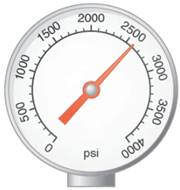
(a)
Interpretation:
In the pressure gauge, which is used for scuba diving, the indicated pressure needs to be determined.
Concept Introduction:
Pressure is defined as the force applied per unit surface area. There are many techniques used for measurement. In the case of fluids, it is the force applied by the particles of the liquid on the walls of the container.
Answer to Problem 7.39P
The reading on the pressure gauge shows 2600 psi.
Explanation of Solution
The pressure gauge as shown in the diagram has scale reading from 0 to 4000. Each unit is 500 psi and there are 4 subdivisions between each unit. This means that from 0 -500, each subunit is to be considered as 100 psi.
Now taking a closer look at the needle pointer, it is seen that the needle is one unit after 2500. This means that it is read as 2500+100=2600.
Thus, the needle indicating the pressure on the pressure gauge is 2600 psi.

(b)
Interpretation:
The measured pressure in psi needs to be converted into mm Hg.
Concept Introduction:
The standard atmospheric pressure is equivalent to 760mm Hg. This unit is roughly equal to the atmospheric pressure.
Also, the relation between the pressure in psi and atmospheric pressure is as follows:
Answer to Problem 7.39P
The value after converting pressure in psi to mmHg is
Explanation of Solution
The conversion of psi to mmHg is as follows:
1 psi = 51.71484 mmHg
Hence, 2600 psi is converted as
Therefore, the pressure value is
Want to see more full solutions like this?
Chapter 7 Solutions
General, Organic, & Biological Chemistry
- (a) 21.8 Name the following compounds. & (b) Br (e) O₂N. (h) H (c) Br (d) NH2 ☑N Br H ہیں Ph (g) OMe бл .0-0.e 21.9 Draw a structural formula for each compound. (a) 2,3-Dinitrotoluene (c) Diphenylmethanol (e) p-Nitroaniline (b) 3-Propylanisole (d) m-Propylphenol (f) Pentabromobenzenearrow_forwardIs this the major product of this reaction?arrow_forwardPlease helparrow_forward
 Living By Chemistry: First Edition TextbookChemistryISBN:9781559539418Author:Angelica StacyPublisher:MAC HIGHER
Living By Chemistry: First Edition TextbookChemistryISBN:9781559539418Author:Angelica StacyPublisher:MAC HIGHER World of Chemistry, 3rd editionChemistryISBN:9781133109655Author:Steven S. Zumdahl, Susan L. Zumdahl, Donald J. DeCostePublisher:Brooks / Cole / Cengage Learning
World of Chemistry, 3rd editionChemistryISBN:9781133109655Author:Steven S. Zumdahl, Susan L. Zumdahl, Donald J. DeCostePublisher:Brooks / Cole / Cengage Learning Introductory Chemistry: A FoundationChemistryISBN:9781285199030Author:Steven S. Zumdahl, Donald J. DeCostePublisher:Cengage Learning
Introductory Chemistry: A FoundationChemistryISBN:9781285199030Author:Steven S. Zumdahl, Donald J. DeCostePublisher:Cengage Learning Introductory Chemistry: A FoundationChemistryISBN:9781337399425Author:Steven S. Zumdahl, Donald J. DeCostePublisher:Cengage Learning
Introductory Chemistry: A FoundationChemistryISBN:9781337399425Author:Steven S. Zumdahl, Donald J. DeCostePublisher:Cengage Learning General Chemistry - Standalone book (MindTap Cour...ChemistryISBN:9781305580343Author:Steven D. Gammon, Ebbing, Darrell Ebbing, Steven D., Darrell; Gammon, Darrell Ebbing; Steven D. Gammon, Darrell D.; Gammon, Ebbing; Steven D. Gammon; DarrellPublisher:Cengage Learning
General Chemistry - Standalone book (MindTap Cour...ChemistryISBN:9781305580343Author:Steven D. Gammon, Ebbing, Darrell Ebbing, Steven D., Darrell; Gammon, Darrell Ebbing; Steven D. Gammon, Darrell D.; Gammon, Ebbing; Steven D. Gammon; DarrellPublisher:Cengage Learning Chemistry by OpenStax (2015-05-04)ChemistryISBN:9781938168390Author:Klaus Theopold, Richard H Langley, Paul Flowers, William R. Robinson, Mark BlaserPublisher:OpenStax
Chemistry by OpenStax (2015-05-04)ChemistryISBN:9781938168390Author:Klaus Theopold, Richard H Langley, Paul Flowers, William R. Robinson, Mark BlaserPublisher:OpenStax





